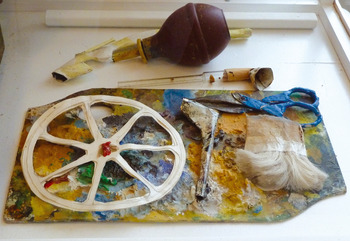The artist Ovartaci was a patient at the psychiatric hospital in Risskov, near Aarhus, Denmark. Ovartaci's real name was Louis Marcussen. He invented the name Ovartaci during his stay at the hospital inspired by other titles at the hospital: ‘chief psychiatrist’ and ‘head nurse’. He saw himself as the most important patient – ‘overtosse’.
As a young man, he trained as a house painter before going to Argentina for 5 years where he worked, vagabondised and experimented with narcotics. Returning to Denmark Louis Marcussen was ill and physically ravaged, and his family felt they could no longer be responsible for his actions. He was sent to the psychiatric hospital at Risskov and diagnosed a schizophrenic. He died in 1985, at the age of 91, after a total of 56 years' hospitalisation.
In the early part of his hospitalisation, he took up his craft. He painted the walls of his room, he painted and created tall, slim figurines of women and he made models and dolls – some with moveable parts. He planned and built his own helicopter and at the beginning of the 1950s he started his battle to become a woman – he became his own creator.
Ovartaci saw the female as a refined being with a full control of her body and sexual desires. This was his reasoning for wanting the gender change to a woman. In the last years of his life, the spark was gone. His visions and fantasies were weakened. He distanced himself from his work and applied to his gender identity again. He insisted on being addressed as a man and reverted to a masculine look.
A fully integrated part of life
Ovartaci's work was a fully integrated part of his life. He did not have the modern-day artists’ self-conscious and targeted thoughts about exhibitions and an audience for this art – nor an art world ‘outside’.
His art was created under very special conditions. A life of deprivation where the closest relations were the hospital staff and where he had to fight for his personal and private space among many other patients. At the same time, this sheltered life gave him a kind of freedom – Ovartaci could concentrate on his many artistic projects without having to think about elementary needs. In the middle of all this, he battled paranoid illusions from time to time, where he went back through a previous life and imagined worlds and beings that were as real to him as the bed he slept in.
How do we relate to his work?
Today we understand the meaning of Outsider Art, ‘raw art’ and ‘rough art’, all labels referring to the concept of Art Brut, a definition given by French artist Jean Dubuffet to describe all the art created outside the boundaries of official culture (Abadie, Reference Abadie1986; Davies, Reference Davies2009) and studied by Roger Cardinal in his book Outsider Art (Cardinal, Reference Cardinal1972). But 70 years after this concept was introduced, is it still reasonable to ask if Outsider Art really is outside the art world, or should it be considered as inside?
In the last few decades, there has been an increased interest in art created by people with mental illnesses. At the Museum Ovartaci we have experienced the interest first-hand from other branches of art, a large part of the cultural institutions and private collectors. We believe it is reasonable to ask: why on the one hand Outsider Art is considered outside, while on the other, we see great qualities in this type of art and happily show it in modern-day art institutions? Is it the knowledge about the marginalised and mad artist seen in a romantic light? (Beveridge, Reference Beveridge2001) Is it the spontaneity and genuineness of the unpolished work? In my opinion, it should be the latter and for that reason, one needs to be very careful in one's approach. The art should be treated in the same way with empathy and respect for the artist and the origin of the artwork.
Personally, I have never liked the term Outsider Art, because ‘being an outsider’ says more about the artist's place in a man-made pattern in the art world and society than about the artwork as such. Art Brut, on the other hand, focuses on the work and describes it as raw and unedited as part of the qualities.
A third place
Irrespective of whether you know about Ovartaci's background and the story of his life, his work will always be etched on the viewer's imagination. Everybody is touched by his work. Inevitably this raises the question why a certain insight into his life and biography will add several important dimensions to his art. However, it is important to see the art and the artist rather than his illness – and at the same time see the work and art as giving access to a third-place that is neither outside nor inside.

Fig. 1. “Ovartaci's palette with a colour wheel and a brush made from his own hair” (mixed materials).

Fig. 2. “Mother and nursing child”. No title. Paper cut, gouache. 6,5 × 17 cm.
About the author
Mia Lejsted is Director of the Museum Ovartaci, Aarhus, since December 2004. The Museum holds two collections: one about the history of psychiatry and an extensive art collection. The Museum also provides a framework for and practises a great deal of social responsibility. Over the past decade, the Museum has undergone major changes organisationally and developmentally. Today, it is an independent institution that is facing even greater change.
Carole Tansella, Section Editor






